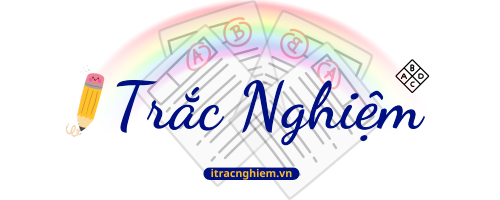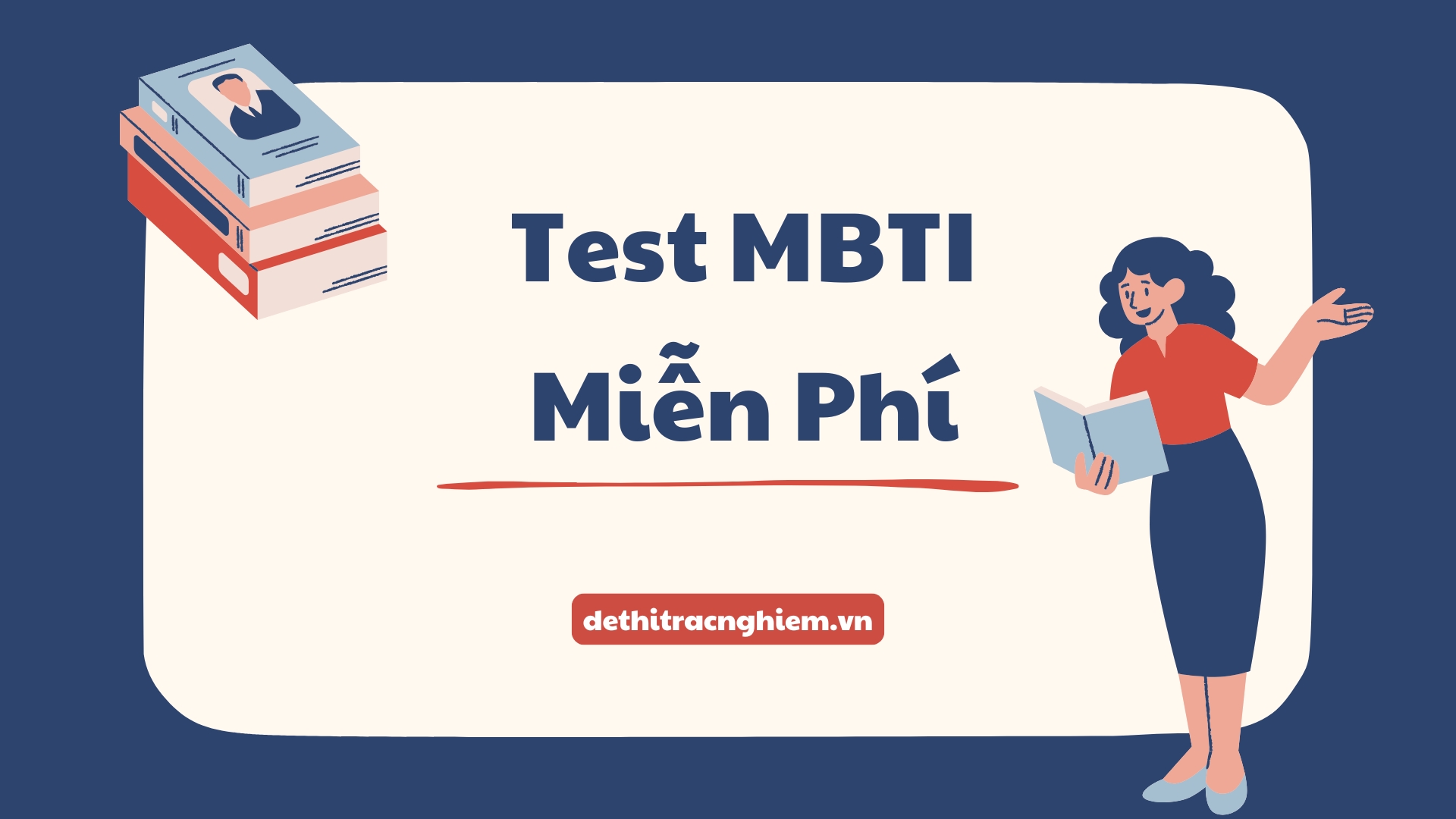Đề thi thử Đại học 2025 môn Tiếng Anh – Sở GD&ĐT tỉnh Sóc Trăng là một trong những đề tiêu biểu thuộc Tổng hợp đề thi thử môn Tiếng Anh THPT QG, nằm trong chương trình Đề thi vào Đại học. Đây là đề thi được biên soạn bởi Sở Giáo dục và Đào tạo tỉnh Sóc Trăng nhằm giúp học sinh lớp 12 ôn luyện và làm quen với cấu trúc chuẩn của đề thi tốt nghiệp THPT môn Tiếng Anh năm 2025.
Đề thi bao quát đầy đủ các nội dung quan trọng của chương trình THPT như: ngữ âm (phát âm và trọng âm), ngữ pháp – từ vựng cơ bản đến nâng cao, tình huống giao tiếp, chức năng ngôn ngữ, cùng với các đoạn đọc hiểu và điền từ nhằm kiểm tra kỹ năng sử dụng ngôn ngữ trong văn cảnh thực tế. Ngoài ra, đề còn có tính phân loại cao thông qua các câu hỏi nâng cao, phù hợp với xu hướng ra đề mới của Bộ GD&ĐT và định hướng phát triển năng lực toàn diện cho học sinh.
Hãy cùng Dethitracnghiem.vn khám phá đề thi này và bắt đầu luyện tập để vững vàng bước vào kỳ thi THPT Quốc gia 2025!
- Số trang: 4 trang
- Hình thức: Trắc nghiệm
- Thời gian làm bài: 50 phút (không kể thời gian phát đề)
ĐỀ THI THỬ ĐẠI HỌC MÔN TIẾNG ANH NĂM 2025 SỞ GD&ĐT TỈNH SÓC TRĂNG
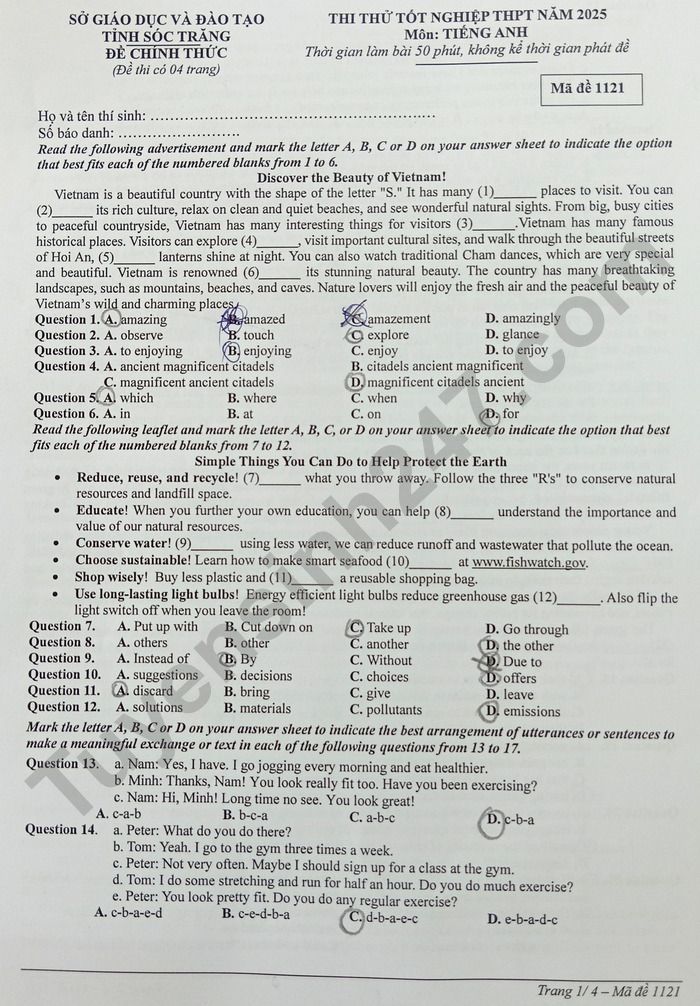

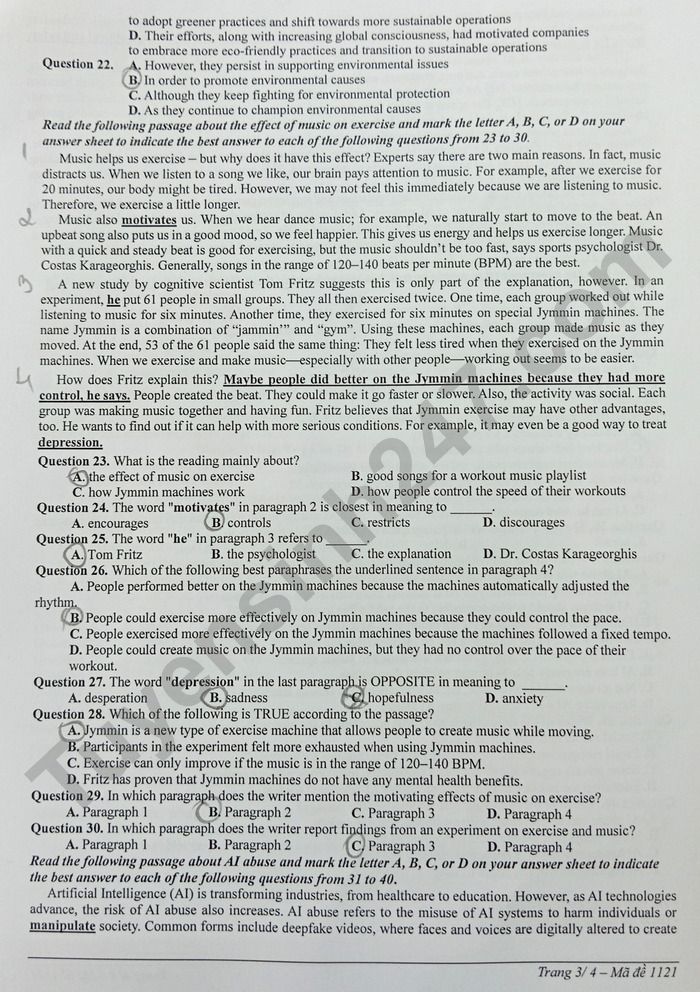
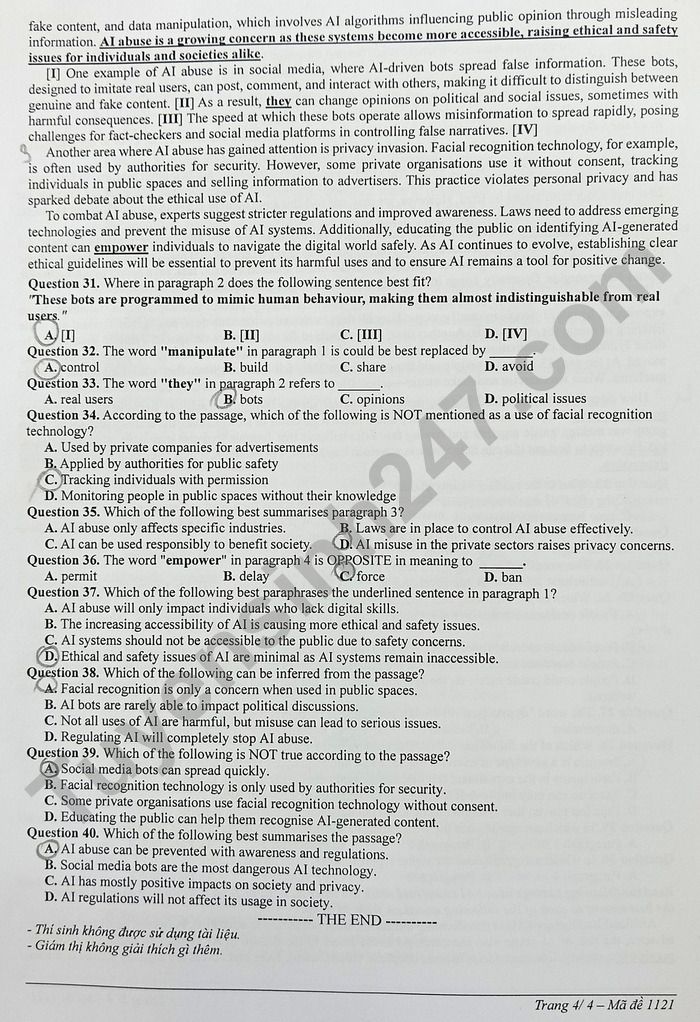
Question 1: Discover the Beauty of Vietnam!
Vietnam is a beautiful country with the shape of the letter “S”. It has many (1) ______ places to visit. You can (2) ______ its rich cultural relics, clean and quiet beaches, and see wonderful natural sights. From big, busy cities to peaceful countryside, Vietnam has many interesting things for visitors (3) ______. Vietnam has many famous historical places. Visitors can explore (4) ______ visit important cultural sites, and walk through the beautiful streets of Hoi An. (5) ______, lanterns shine it night. You can also watch traditional Cham dances, which are very special and beautiful. Vietnam is renowned (6) ______ its stunning natural beauty. The country has many breathtaking landscapes, such as mountains, beaches, and caves. Nature lovers will enjoy the fresh air and the peaceful beauty of Vietnam’s wild and charming places.
A. amazing
B. amazed
C. amazement
D. amazingly
Question 2:
A. observe
B. touch
C. explore
D. touch
Question 3:
A. to enjoying
B. enjoying
C. enjoy
D. to enjoy
Question 4:
A. ancient magnificent citadels
B. ancient magnificent citadels
C. magnificent ancient citadels
D. ancient citadels ancient magnificent
Question 5:
A. which
B. where
C. when
D. why
Question 6:
A. in
B. at
C. on
D. for
Read the following leaflet and mark the letter A, B, C, or D on your answer sheet to indicate the option that best fits each of the numbered blanks from 7 to 12.
Simple Things You Can Do to Help Protect the Earth
Reduce, reuse, and recycle! (7) ______ what you throw away. Follow the three “R’s” to conserve natural resources and landfill space.
Educate! When you further your own education, you can help (8) ______ understand the importance and value of our natural resources.
Conserve water! (9) ______ using less water, we can reduce runoff and wastewater that pollute the ocean.
Choose sustainable! Learn how to make smart seafood (10) ______ at www.fishwatch.gov.
Shop wisely! Buy less plastic and (11) ______ a reusable shopping bag.
Use long-lasting light bulbs! Energy efficient light bulbs reduce greenhouse gas (12) ______. Also flip the light switch off when you leave the room!
Question 7:
A. Put up with
B. Put down on
C. Take up
D. Go through
Question 8:
A. Others
B. Other
C. another
D. The other
Question 9:
A. Instead of
B. By
C. Without
D. Due to
Question 10:
A. suggestions
B. decisions
C. choices
D. offers
Question 11:
A. discard
B. bring
C. give
D. leave
Question 12:
A. solutions
B. materials
C. pollutants
D. emissions
Mark the letter A, B, C or D on your answer sheet to indicate the best arrangement of the sentences or utterances to make a meaningful exchange from 13 to 17.
Question 13: Nam: Yes, I have. I go jogging every morning and eat healthier.
a. Minh: I’m trying to eat healthier and exercise more. My doctor advised me to lose some weight.
b. Minh: Thanks, Nam! You look really fit too. Have you been exercising?
c. Nam: Hi, Minh! Long time no see. You look great!
A. c-a-b
B. b-c-a
C. a-b-c
D. c-b-a
Question 14: Nam: What do you do there?
a. Peter: You look pretty fit. Do you do any regular exercise?
b. Peter: Yeah. I go to the gym three times a week.
c. Peter: Not very often. Maybe I should sign up for a class at the gym.
d. Tom: I do some stretching and run for half an hour.
A. a-b-c-d
B. c-e-d-b-a
C. c-a-b-c
D. c-b-a-d
Question 15: Hey: Nam!
a. The first play we’re working on is a comedy, and I get to play a funny character.
b. I’ve only had a few meetings so far, but I already love the group and the activities.
c. I want to share that I have recently joined the drama club at school.
d. The other members are super supportive and help me feel comfortable right away.
e. I’ll invite you to our performance once we’re ready. I think you’ll really enjoy it.
A. a-b-c-d-e
B. c-b-a-d-e
C. c-b-d-a-e
D. c-e-b-d-a
Question 16: Outdoor learning also encourages teamwork and collaboration among students.
a. Today, I would like to speak on the value of outdoor learning experiences for young people.
b. By engaging with nature, students can develop a sense of responsibility for the environment.
c. The first benefit is that it provides opportunities to apply classroom knowledge in real-world settings.
d. In conclusion, outdoor learning offers numerous benefits that support both academic and personal growth.
A. d-b-a-c-e
B. b-c-a-d-e
C. b-d-a-c-e
D. c-e-b-d-a
Question 17: a. To begin with, recycling electronic devices prevents harmful chemicals, such as lead and mercury, from entering the soil and water, protecting human health and the environment.
b. Recycling electronics plays a critical role in sustainability, reducing waste and preserving resources.
c. For example, when we recycle old phones and computers, valuable materials like metals and plastics can be reused, lowering the need to extract new resources.
d. Additionally, keeping e-waste out of landfills not only reduces pollution but also conserves finite natural resources.
e. In short, recycling electronics responsibly supports a cleaner planet and a sustainable future for coming generations.
A. a-b-c-d-e
B. b-a-c-d-e
C. b-a-d-c-e
D. c-e-b-d-a
Read the following passage about green lifestyle and mark the letter A, B, C, or D on your answer sheet to indicate the option that best fits each of the numbered blanks from 18 to 22.
In recent years, the importance of adopting a green lifestyle has become increasingly evident, especially among the younger generation. Today’s youth are more environmentally conscious than ever, and (18) ______ a green lifestyle, characterized by eco-friendly habits such as reducing waste, conserving resources, and making environmentally responsible choices, (19) ______ understand the importance and value of our natural resources.
Young people today are more likely to embrace sustainable practices, such as using reusable products, reducing plastic consumption, and opting for renewable energy sources. Many are also advocates for plant-based diets. (20) ______, social media platforms have played a significant role in spreading awareness, with influencers and activists urging their peers to make environmentally conscious choices.
Additionally, youth are actively involved in climate activism, participating in various movements like Fridays for Future, and advocating for policy changes that address environmental issues. (21) ______, a green lifestyle among the youth is not just a trend but a vital shift toward a more sustainable future. (22) ______, they will undoubtedly inspire future generations to live more responsibly, ensuring a healthier planet for all.
Question 18:
A. embracing
B. embracing
C. adopting
D. pursuing
Question 19:
A. help to
B. helps to
C. helping to
D. helps them to
Question 20: Mark the letter A, B, C, or D on your answer sheet to indicate the option that best fits the blank.
A. In conclusion
B. However
C. Otherwise
D. Furthermore
Question 21: Mark the letter A, B, C, or D on your answer sheet to indicate the option that best fits the blank.
A. In general
B. All in all
C. For example
D. In other words
Question 22: Mark the letter A, B, C, or D on your answer sheet to indicate what the underlined word refers to.
A. future generations
B. eco-friendly habits
C. resources
D. youth
Read the following passage about the effect of music on exercise and mark the letter A, B, C, or D on your answer sheet to indicate the best answer to each of the following questions from 23 to 30.
Music helps us exercise – but why does it have this effect? Experts say there are two main reasons. In fact, music distracts us. When we listen to a song we like, our brain pays attention to music. For example, after we exercise for 20 minutes, our body might be tired. However, we may not feel this immediately because we are listening to music. Therefore, we exercise a little longer.
Music also motivates us. When we hear dance music, for example, we naturally start to move to the beat. An upbeat song also puts us in a good mood, so we feel happier. This gives us energy and helps us exercise longer. Music with a quick and steady beat is good for exercising, but make sure it shouldn’t be too fast, says sports psychologist Dr. Costas Karageorghis. Generally, songs in the range of 120–140 beats per minute (BPM) are the best.
A new study by cognitive scientist Tom Fritz suggests this is only part of the explanation, however. In an experiment, he put 61 people in small groups. They all then exercised one. Each group worked out while listening to music for six minutes. At another time, they exercised for six minutes on special Jymmin machines. The name Jymmin is a combination of “Jym” and “Jazmin.” Using these machines, each group made music as they moved. At the end, 53 of the 61 people said the same thing: They felt less tired when they exercised on the Jymmin machines. When we exercise and make music—especially with other people—working out seems to be easier.
How does Fritz explain this? Maybe people did better on the Jymmin machines because they had more control as they made music together and had fun. Fritz believes that Jymmin exercise may have other advantages, too. He wants to find out if it can help with more serious conditions. For example, it may even be a good way to treat depression.
Question 23: What is the reading mainly about?
A. The positive effect of music and exercise.
B. how Jymmin machines work
C. how people control the speed of their workouts
D. how music can make us feel tired
Question 24: The word ‘motivates’ in paragraph 2 is closest in meaning to
A. encourages
B. controls
C. restricts
D. discourages
Question 25: The word ‘he’ in paragraph 4 refers to
A. Tom Fritz
B. the psychologist
C. the explanation
D. Dr. Costas Karageorghis
Question 26: Which of the following best paraphrases the underlined sentence in paragraph 4?
A. People could exercise more effectively on Jymmin machines as they could control the pace.
B. People exercised more effectively on the Jymmin machines because the machines followed a fixed tempo.
C. People could create music on the Jymmin machines, but they had no control over the pace of their workout.
D. Exercise on Jymmin machines is not as effective as other types of exercise.
Question 27: The word ‘depression’ in the last paragraph is OPPOSITE in meaning to
A. desperation
B. sadness
C. hopefulness
D. anxiety
Question 28: Which of the following is TRUE according to the passage?
A. Jymnin is a new type of exercise machine that allows people to create music while moving.
B. Participants in the experiment felt more exhausted when using Jymmin machines.
C. Fritz has proven that Jymmin machines do not have any mental health benefits.
D. Exercise can only improve if the music is in the range of 120-140 BPM.
Question 29: In which paragraph does the writer mention the motivating effects of music on exercise?
A. Paragraph 1
B. Paragraph 2
C. Paragraph 3
D. Paragraph 4
Read the following passage about AI abuse and mark the letter A, B, C, or D on your answer sheet to indicate the best answer to each of the following questions from 30 to 40.
Artificial Intelligence (AI) is transforming industries, from healthcare to education. As AI technologies advance, the risk of AI abuse also increases. AI abuse refers to the misuse of AI systems to harm individuals or manipulate society. Common forms include deepfake videos, where voices and faces are digitally altered to create fake content, and data manipulation, which involves AI algorithms influencing public opinion through misleading information. [I] AI abuse is a growing concern as these systems become more accessible, raising ethical and safety issues for individuals and societies alike.
[II] One example of AI abuse is social media, where AI-driven bots spread false information. These bots, designed to imitate real users, can post, comment, and interact with others, making it difficult to distinguish between genuine and fake content. [III] The speed at which these bots allow misinformation to spread rapidly, posing harmful consequences. Also the ease with which they can change opinions on political and social issues, sometimes with harmful consequences.
[IV] Another area that AI abuse has gained attention is privacy invasion. Facial recognition technology, for example, is often used by authorities for security. However, some private organisations use it without consent, tracking individuals in public spaces and selling information to advertisers. This practice violates personal privacy and has sparked debate about the ethical use of AI.
[V] To combat AI abuse, experts suggest stricter regulations and improved awareness. The public needs to address emerging technologies and prevent the misuse of AI systems. Additionally, educating the public can help empower individuals to navigate the digital world safely. As AI continues to evolve, establishing clear ethical guidelines will be essential to adopt greener practices and shift towards more sustainable operations. Their efforts, accompanied with increasing global consciousness, urging companies to adopt more eco-friendly practices and switch to sustainable operations to adopt greener practices and shift towards more sustainable operations.
Question 30: These bots are programmed to mimic human behaviour, making them almost indistinguishable from real users.
In which paragraph does this sentence fit best?
A. [I]
B. [II]
C. [III]
D. [IV]
Question 31: The word ‘manipulate’ in paragraph 1 could be best replaced by
A. control
B. build
C. share
D. avoid
Question 32: What do the word ‘they’ in paragraph 2 refer to?
A. real users
B. bots
C. opinions
D. political issues
Question 33: According to the passage, which of the following is NOT mentioned as a use of facial recognition technology?
A. Used by private companies for advertisements
B. Applied by authorities for public safety
C. Tracking individuals with permission
D. Monitoring people in public spaces without their knowledge
Question 34: Which of the following best summarises paragraph [III]?
A. AI abuse affects specific industries.
B. Laws are in place to control AI abuse effectively.
C. AI can be used responsibly to benefit society.
D. AI misuse in the private sectors raises privacy concerns.
Question 35: The word ’empower’ in paragraph 5 is OPPOSITE in meaning to
A. permit
B. delay
C. force
D. ban
Question 36: Which of the following paraphrases the underlined sentence in paragraph 1?
A. AI abuse is a growing concern that can be easily solved.
B. The accessibility of AI systems reduces ethical issues.
C. The increasing accessibility of AI is causing more ethical and safety issues.
D. Ethical and safety issues of AI are minimal.
Question 37: Which of the following is NOT true according to the passage?
A. Facial recognition technology is only used in public spaces.
B. Bots are able to manipulate political discussions.
C. Not all uses of AI are harmful to society.
D. AI systems should not be accessible to the public due to safety concerns.
Question 38: Which of the following can be inferred from the passage?
A. Facial recognition technology is only a concern when used in public spaces.
B. Social media bots spread quickly.
C. Some private organisations use facial recognition technology without consent.
D. Educating the public can help them recognise AI-generated content.
Question 39: Which of the following is NOT true according to the passage?
A. Social media bots can spread quickly.
B. Social media bots are the most dangerous AI technology.
C. AI has mostly positive impacts on society and privacy.
D. AI regulations will not affect its usage in society.
Question 40: Which of the following best summarises the passage?
A. AI abuse can be prevented with awareness and regulations.
B. Social media bots are the most dangerous AI technology.
C. AI has mostly positive impacts on society and privacy.
D. AI regulations will not affect its usage in society.
Mục đích tổ chức kỳ thi Đại học năm 2025 là gì?
Căn cứ theo quy chế hiện hành của Bộ Giáo dục và Đào tạo và các văn bản hướng dẫn tổ chức kỳ thi Đại học năm 2025, mục đích của kỳ thi là:
– Đánh giá kết quả học tập của học sinh sau 12 năm học theo yêu cầu của chương trình giáo dục phổ thông.
– Lấy kết quả thi để xét công nhận tốt nghiệp trung học phổ thông và làm căn cứ tuyển sinh đại học, cao đẳng.
– Góp phần đánh giá chất lượng giáo dục của địa phương và cả nước, làm cơ sở điều chỉnh nội dung, phương pháp dạy học trong nhà trường.
Thí sinh thi Đại học năm 2025 có bắt buộc thi môn Tiếng Anh không?
Theo quy định hiện hành của Bộ Giáo dục và Đào tạo và hướng dẫn tổ chức kỳ thi tốt nghiệp Đại học năm 2025, thí sinh dự thi phải thực hiện như sau:
– Thi 3 môn bắt buộc: Toán, Ngữ văn và Ngoại ngữ.
– Ngoài ra, thí sinh phải chọn một trong hai bài thi tổ hợp: Khoa học Tự nhiên (gồm các môn Vật lí, Hóa học, Sinh học) hoặc Khoa học Xã hội (gồm các môn Lịch sử, Địa lí, Giáo dục công dân – dành cho học sinh học chương trình giáo dục phổ thông).
Trong số các môn thi, Tiếng Anh là một trong ba môn thuộc bài thi Ngoại ngữ bắt buộc, thí sinh phải thi môn Tiếng Anh như một môn bắt buộc, không phụ thuộc vào lựa chọn bài thi tổ hợp hay mục đích xét tuyển đại học.
Như vậy, kỳ thi Đại học năm 2025 bắt buộc thí sinh phải thi môn Tiếng Anh.
